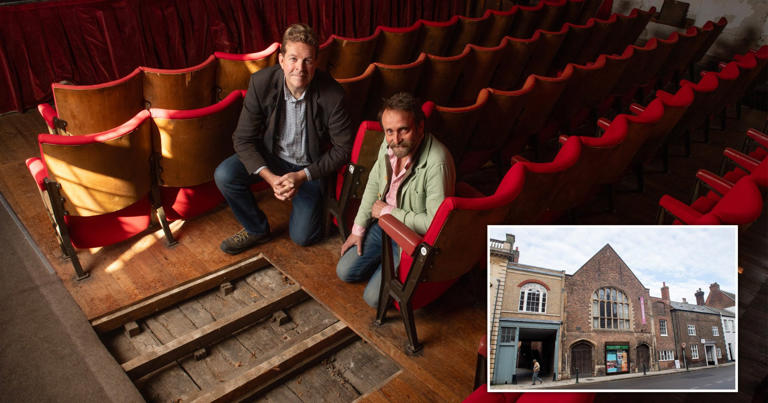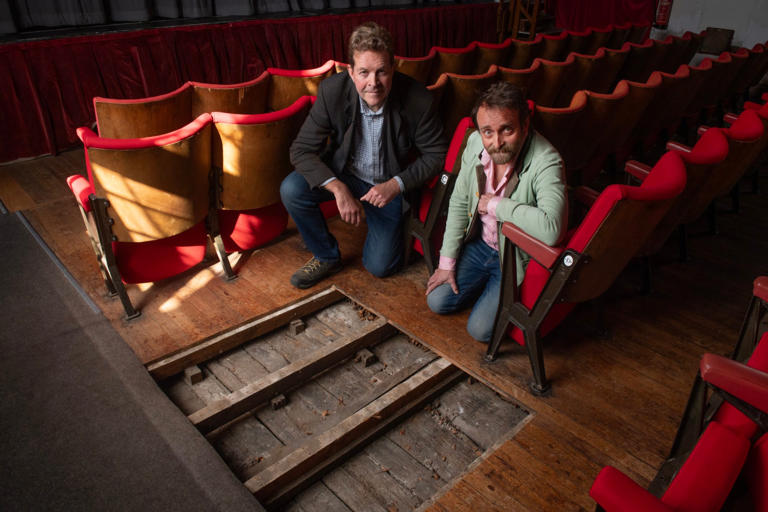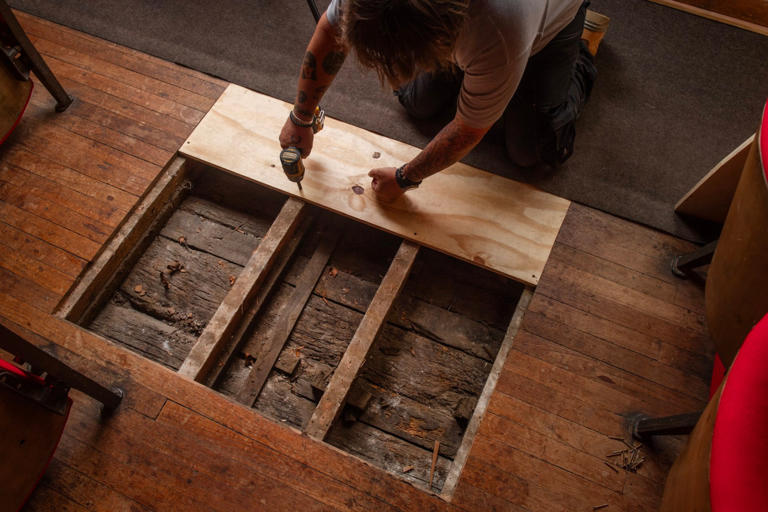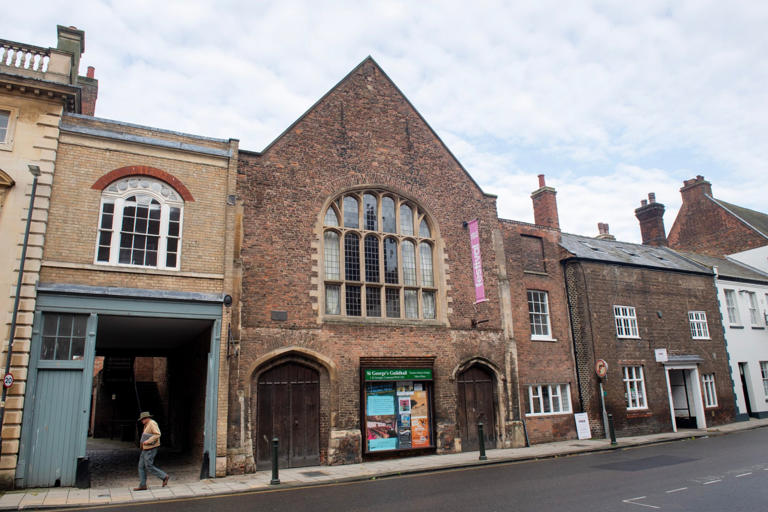Story by Katie Boyden • METRO UK

Nobody knew the ancient floorboards were hidden under layers of newer floors (Picture: BNPS)© Provided by Metro
All the world’s a stage and all the men and women merely players; they have their exits and their entrances.
But among those who made their exits and their entrances on this particular stagein King’s Lynn was none other than William Shakespeare.
These humble looking pieces of wood are believed to be the last remaining boards the bard trod on more than 400 years ago.
They were discovered in England’s oldest medieval guildhall and have really got historians going.
The oak floorboards are believed to be 600 years old and form part of the only surviving stage in the world from Shakespeare’s time.
The stage was hidden under several layers of modern flooring and were only discovered during a refurbishment.
Professor Sir Stanley Wells, who has written numerous books on Shakespeare, said: ‘Everyone interested in Shakespeare and in the theatres of his time must feel a thrill of excitement at the discovery of the only surviving boards on which he is likely to have performed.’
Dr Paul Edmundson, head of research at the Shakespeare Birthplace Trust, added: ‘To see the medieval stage where Shakespeare might have performed rediscovered after centuries is an exciting opportunity.
‘It’s a unique survival of theatre performances from a great period of English drama. This is a truly special discovery.’
The guildhall was built in the 1400s, and is the only theatre in the world which can claim Shakespeare performed there.

Dr Jonathan Clark, the archaeologist leading the project (left), and actor Tim FitzHigham (right) with the uncovered Shakespeare floor boards (Picture: BNPS)© Provided by Metro

The boards were found under three layers of newer flooring (Picture: BNPS)© Provided by Metro
It was used extensively at the time for touring companies.
In 1593 London’s theatres were closed because of another outbreak of plague and William Shakespeare and his company of actors were on tour in King’s Lynn.
A note in the theatre’s account book shows Shakespeare’s company were paid by the borough to perform there.
The area has other links to the famous playwright that also backs up the case.
Robert Armin, who was Shakespeare’s leading comic actor, playing parts like Feste in Twelfth Night and the Fool in King Lear, was born in the town, one street away from the theatre.
There is also evidence, in a book published in Shakespeare’s lifetime, of an incident that happened at the King’s Lynn theatre – where an audience member watching a play about a murder was so consumed with guilt she confessed to killing her husband.
It is thought that incident inspired part of the plot of Hamlet – the Murder of Gonzago/Mousetrap scene.

William Shakespeare will have trod these very boards more than 400 years ago (Picture: BNPS)© Provided by Metro
The Grade I Listed building was derelict and in danger of demolition by 1945 before it was bought by a local landowner and turned into an arts centre.
It was given to the National Trust in 1951 and is now leased to and managed by King’s Lynn and West Norfolk Borough Council.
But the site, which also has an art gallery and lecture space, has been under-used in recent years and its future looked uncertain again in 2016.
Actor and comedian Tim FitzHigham, who is originally from King’s Lynn, joined efforts to secure the building’s future and last year he took on the role of creative director at the council.
The guildhall received funding for a major restoration and archaeological work, which has been underway at the site for the last two months.
This has revealed the original floor, hidden underneath one that was laid in the 1950s and a second from the 18th or 19th century.
Some of the original wood floor has been scientifically tested and dated to between 1417 and 1430, when the building was created.
The large oak boards are almost 12ins wide and 6ins thick and held together with wooden pegs rather than nails.
It is believed the floor would have been laid by shipwrights and taken about a year to create.
Mr FitzHigham said: ‘I first heard the tale that Shakespeare had performed at the Guildhall as a kid but when I went back as an adult it seemed King’s Lynn had forgotten about it.
‘Before I became creative director at the council, I had been involved in researching the history of the venue. We were able to demonstrate the connection of the town with Robert Armin and Shakespeare.
‘We were also able to confirm we have the account book showing that the borough paid Shakespeare’s company to perform. It is highly likely that the Bard himself would have joined them.
‘A lot of original features remain at the venue that Shakespeare would have been able to see – including the walls, windows and roof timbers.
‘But experts are now confidently saying these are the floorboards Shakespeare would have trodden, it makes this building important nationally and internationally.

These could be the oldest surviving floorboards in England – or even Europe (Picture: BNPS)© Provided by Metro

St George’s Guildhall was built in the 1400s (Picture: BNPS)© Provided by Metro
‘When we uncovered it, I was completely blown away. To have the documents around that mean you can say this is where Shakespeare performed is remarkable. To then have the actual floor he performed on is a different league.
‘This is one of the most extraordinary people we have got in Britain. Everyone in the world knows about Shakespeare, so to find a floor like that is pretty magical.
‘As archaeological finds go this is right up there. It is so rare to get a 15th century floor and the sheer scale of this is just extraordinary.
‘It’s a massive discovery. The experts tell me this is the largest timber framed 15th century floor in the country and possibly Europe, that’s before you even add the Shakespeare connection.
‘They’ve done testing on the wood to date the boards to 1417-1430 so it would have been the floor Shakespeare performed on in 1593.
‘To have the timber still there is very rare in a building that old. It’s a really rare survival, we are very lucky.
‘The main reason it’s still there is because it’s totally integral to the building, you can’t really take it out without destroying the floor so they either had to patch it up or put another floor on top, which is why it’s still intact.
‘I think this could put the guildhall on the map worldwide – I would travel to see the floor Shakespeare performed on and I’m sure others would as well.’
The team is now working out how to showcase Shakespeare’s floor without damaging it.
No comments:
Post a Comment